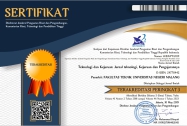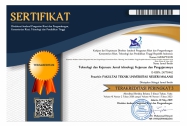Author Guidelines
1. General
● An article written for Teknologi dan Kejuruan: Jurnal Teknologi, Kejuruan, dan Pengajarannya/Technology and Vocational: Journal of Technology, Vocational, and Learning covers the results of research and conceptual thinking in the fields of technology, vocational, and learning. Written in Indonesian or English with in the essay two columns format. Type the manuscript with MS Word font Times New Roman, size 12 pts , with spaces At least 12 pts ( single ), two columns printed, except title and abstract, on A4 paper. Distance between the columns is 8 mm, 25 mm top margin, bottom 20 mm, left 35 mm, and 25 mm right, as much as 10-15 page. Send the article to the Journal website: http://journal2.um.ac.id/index.php/teknologi-kejuruan/login. If you have any problem in submitting your paper, you can contact the administrator via e-mail address: teknologikejuruan.ft@um.ac.id.
Article published does not cost you anything (free) .
● The author's name is listed without an academic degree, drafted down, and placed under the heading of the article. If the article is a result from a work/study group, the member names must be included with the lead author's name at the top. The author's description must include the majors, faculty, college, and address in the first page's footnotes. Other information that is considered important, such as the research's type and duration can also be included in the footnotes.
2. Articles for Research Results
● The systematical of the research includes the title, author name, abstract and keywords, introduction, methods, results, discussion, conclusions and recommendations, and a list of references.
● Abstract is written English in the Times New Roman font, size 11 pt , single-spaced, and one column. The abstract should consist of the title, a summary of the background of the problem, research objectives, methods, and research results. The abstract should not include references with the limitation of ±125 words.
● Keywords are terms that represent ideas or basic concepts related to the realm of the problems studied.
● The introduction did not need to use a title (heading). The introduction is presented in narrative and does not necessary to separate introduction into subsections. The introduction contents include the preliminary background of the problem, a summary of a literature review (theoretical), and end with the purpose of research.
● Method section titled using all capital letters, as well as the results of research, discussion, conclusions and suggestions. This section describes how research is done.
● The results section includes the results of data analysis (not raw data). It can be presented with the help of tables or graphics with explanations or written meaning to the results of the analysis.
● Part discussion contains the discussion of the results with the acknowledgment to the previous research, theory, or already-established knowledge. The results of the research can support, does not support, or even contradictory to the previous researches.
● Conclusion contains a summary of the results of based on the discussion and generalization of the research. Conclusions proves as a further basic to provide good suggestions for practical actions, development of the theory, as well as advanced research.
3. Conceptual Articles
● The systematical of the research includes the title, author name, abstract and keywords, introduction, discussion, conclusions, and a list of references.
● Conceptual abstract contains a title, a summary of the background issues, the importance of the discussion, the contents of the discussion, and conclusion. Other subtances are similar with the research article abstracts.
● The introduction did not need to use a title (heading). Contents include the preliminary background of the problem, the purpose and importance of the discussion, and the scope of the discussion.
● The discussion part can be divided into several sub-sections according to systematic discussion in problem solving .
● Conclusions contain the conclusions of the discussion.
● Conceptual article should use at least 30 references, with the exception if the author is a great teacher.
4. Writing Pictures
Pictures are placed straight left in columns within a single space of a paragraph. If the size of the image passes the width columns then the image can be placed with a single column format. Images can be placed after or before the narrative in the script. Pictures are numbered and sorted by Arabic numerals. The image name is placed below the image within one single space of the image. The written name of the image should use font size 11 pt, bold . When using the information, use smaller letters. Image source reference must be accompanied by this format (Source: author's name, year). Images must be printed in black and white with good quality. When using a color image, make sure it can be printed in black and white with a good quality.
5. Writing Table
Table's title is written with size 11 pt bold font and placed on the table with the format as shown in the example. The data on the table is written with Times New Roman size 11 pt . Numbering tables use Arabic numerals. Between the table and the paragraph is one single space. Tables can be placed before or after the appointment of the manuscript as long as the author has put forward a table or picture is accompanied by a number (Table 2, Figure 7, not the table below or the chart below). If the table has a column that is enough or image large enough, it can use the format of the column (left column merged right column). The table contains only the horizontal lines. If the table contains the result of referrals, it is necessary to mention the source (Source: author's name, and year).
6. References
● Reference should cites as many sources as possible within the last 10 years. Preffered references are primary sources, such as research reports and articles in the journal.
● References and citations should use the enclosed technique: (name, year) or author name (year). Inclusion of a source in a direct quotation should be accompanied by a description of the page number (Strunk & White, 1979:47).
7. Writing References
The materials that were read but not cited in the text should not be included in the reference list, while all the materials cited in the text must be included in the reference list. Writing the references list should be sorted alphabetically. The author's name is written in this order: the last name, first name and middle name, without academic degrees. Writing the first and middle name can be shortened. Our suggestion is to write the references using Mendeley and Zotero.
References from Books
Strunk, W.Jr. & White, EB 1979. The Elements of Style (3 rd ed.). New York: Macmillan.
Reference that Contain References from Books with editors
Letheridge, S. & Cannon, CR (Eds.). 1980. Billingual Education: Teaching English as a Second Language. New York: Praeger.
References from Articles in Journals
Hanafi, A. 1989. Participation in Rural Press and Adoption of Innovation. Forum Research, 1 (1): 33-47.
References from Articles in Magazines or Newspapers
Gardner, H. 1981. Do Babies Sing a Uni versal Song? Psychology Today, p. 70-76.
Huda, 13 November 1991. M. Interrogate Electricity Crisis Dry Season. Jawa Pos, p. 6.
References of Newspapers Without Writer
Jawa Pos. 1995, April 22. Women Underclass More Independent. Hlm.3.
References from an Institute Report
Development and Language Development Center. 1978. Guidelines for Writing Research Report. Jakarta: Ministry of Education and Culture.
References' Form of Translation Work
Ary, D., Jacobs, LC, & Razavieh, A. Without year. Introduction to Educational Research. Translation by Arief Furchan. 1982. Surabaya: National Business.
References from Thesis or Dissertation
Pangaribuan, T. 1992. Development of Kom-compe- Kewacanaan English Language Learners in LPTK. Dissertation published. Malang: Graduate Teachers' Training College Malang.
References from Papers Presented at the Seminar
Karim, Z.1987. City Planning in Developing Countries. Paper presented at a seminar Tatakota, BAPPEDA East Java, Surabaya, 1 to 2 September.
References from the Internet (Individual Work)
Hitchcock, S., Carr, L. and Hall, W. 1996. A Survey of STM Online Journals, 1990-1995: The Calm before the Storm, (Online), http://journal.ecs.soton.ac.uk / survey / survey. html, accessed June 12, 1996).





2.png)
1.png)
1.png)
1.png)
4.png)
1.png)
.png)

3.png)
1.png)
1.png)



